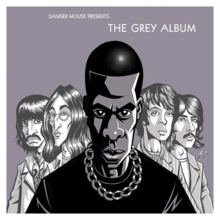99 Problems – Danger Mouse – Danger Mouse – 2004
- February 8th, 2013
- Write comment
OK, let’s remember to listen objectively here. The listening diary is about focusing on what can be heard in the track, over and above the things we may know about the track/artist etc. that cannot be ascertained simply by listening to the track.
So, in this case, let’s forget that it is a mash-up of the vocals from Jay-Z’s Black Album with The Beatles’ White Album. Let’s not highlight the differences between the sources that have been sampled and the samples as they appear in this track, let’s just concentrate on what they sound like now and how they operate within the context of the track.
The track begins with a solo rap vocal. Throughout the track the vocal is dry, as is typical of rap vocal production; no reverb or delay. However there is extensive use of doubling and what I will call ‘harmonising’ – by which I mean a second vocal that reinforces the lead vocal with a slightly different performance style. For example, the second line of the vocal is ‘I got 99 problems’ and is ‘harmonised’ with a slightly whispered vocal.
At the same time the backing enters with a heavily EQed Beatles vocal ahh, the EQ thinning it out and pushing it under the rap vox. There are cymbals and possibly guitars in this Beatles sample but being so heavily processed it is hard to tell.
The main musical backing, which is a bass heavy throb, enters soon after. There is heavy tom thud on the 1 and 3 for a few bars before the throb drops out for the entrance of a snare drum fill accompanied by an electric guitar descending lead line. The throb returns to join a now steady drum beat. Lead guitar lines burst in for a moment then another drop for the return of the thin ahh to show through. Its over this that the ‘chorus’ vocal line is featured. At other times the backing drops out entirely for the vocal to exclaim ‘Hit me!’
This sets the general pattern for the track – alternating between the throb and the drum fill/lead break and the thin ahh and a complete drop out in the backing.
At the 1:15 mark the lead vocal is processed to imitate a traffic cop speaking from a slight distance away. It is thinned a little with EQ and slightly lower in volume so that the two voices (both Jay-Z) can be differentiated in the to and fro of the verbal exchange.
There are some ‘wooh’s and ‘yeah’s at the end that aren’t immediately identifiable as either Jay-Z or the Beatles, mostly because they have reverb on them in a way that seems inconsistent with the rap vocal. The very last moment of sound (a snare drum and a vocal ‘whoop’) reveals a reverb tail that again seems inconsistent with both the Beatles sources and the Jay-Z vox. Perhaps there has been this reverb on the drums and many other aspects of the backing track all the way through, tying them together to sound like one band playing one song rather than a mash of songs.
Notes; in actual fact the backing track is a fairly faithful remake of the Jay-Z original backing, both in terms of thickness and shape, but without staying true to the harmonic content of the Jay-Z track. By that I mean the Beatles samples have not been overtly pitch adjusted to ‘play’ the Jay-Z chords and they retain their recognisability as the Beatles Helter Skelter etc. For example the main lead line from Helter Skelter remains intact melodically, despite that melody not being part of the Jay-Z original. However, it is only used by Danger Mouse at the exact moments when a heavy distorted electric guitar appears in the original.
Overall the production stays faithful to the principle rule of modern production – the vocal remains the focus of the track and is intelligible throughout. The backing serves to add drama and reinforce the lyric narrative. There are moments when the backing track is quite full and stereo is used to make space in the centre of the track for the vocal. However there is little adherence to an obvious verse/chorus structure, which perhaps is a result of mimicking Jay-Z’s original song structure rather than a conscious decision by Danger Mouse.




